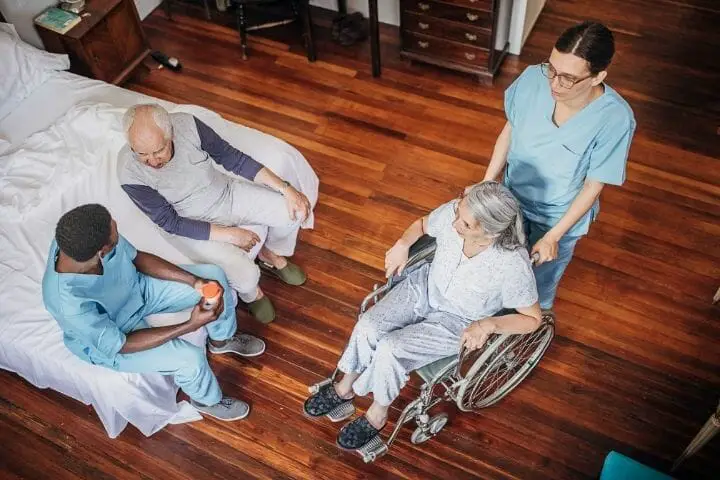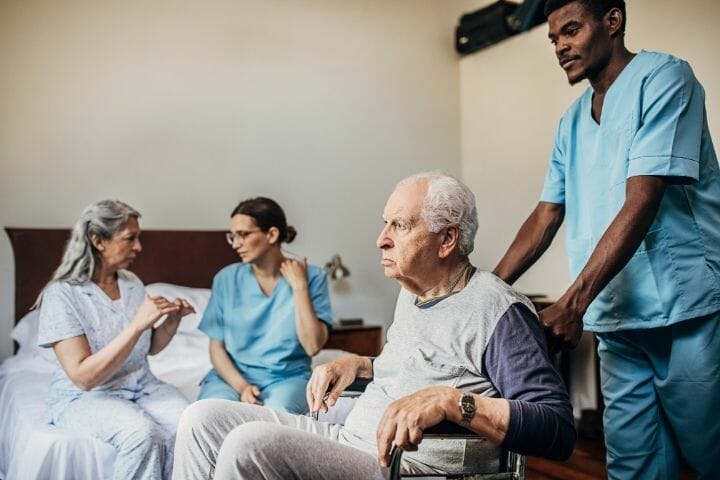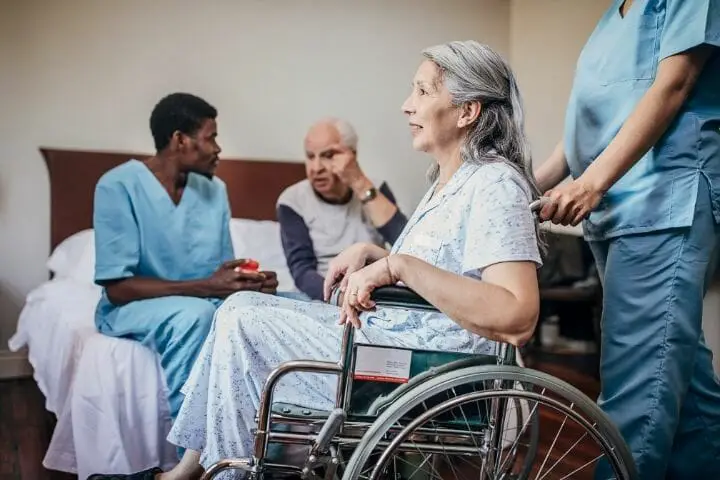Are you or a loved one currently residing in a nursing home? You should understand what is Money Follows the Person Program; it can be very beneficial for you.
Contents
The US Government funds various programs for the betterment of older adults. One such program is the Money Follows The Person” Program.
This program aims to get older adults who are currently residing in a nursing home due to illness or injury back to their own homes with proper home modifications and assistance. The government funds this program in many ways.
If you want to understand the benefits and the goals of this program, then we will discuss these topics in detail in this article.

You might like to read: Planning For Future Care And Support
Money Follows The Person Program
Money Follows The Person is a Medicaid program. This program is designed for older adults who reside in nursing homes.
The program tries to move older adults back to the comfort of their own homes and in the presence of their loved ones, instead of having to live in a nursing home under medical supervision. In some states, the program also helps people at immediate risk of nursing house placement.
This is a federal program, which doesn’t provide any financial grants directly to the individual. Instead, the grant is given to the states so that they can develop their own local Money Follows the Person Program” based upon their best judgment.
These programs use existing Medicaid resources to help family caregivers manage the care of the elderly outside the nursing home.
Federal funds are also used to develop resources that are designed to help individuals in care management, telehealth services, and housing coordination. They use already existing medical resources like HCBS waivers.
What Are The Benefits Of Money Follows the Person Program?
The benefits provided under the Money Follows the Person program can be different from state to state. It also depends upon how much care and assistance the individual needs and how well equipped the home is in which they are shifting.
Money is allocated to make the modifications in the house. For example, the program can pay for wheelchair ramps, adaptive lighting, bathroom safety modifications, and stairlifts.
This increases the safety and independence of the person enrolled in the program. It also provides moving assistance, serving animals, and transportation benefits. These benefits are specific to each state.
You might like to read: An Overview Of Government Benefits For The Disabled

It provides financial assistance to purchase items.
- Accessibility modifications
- Utility startup expenses
- Security deposits
- Furniture
It also provides professional development opportunities:
- MFP roundtable
- MFP Lunch and webinar series
It also provides NC community transitions institute:
- Application process
It provides transition coordination and program operations:
- Guardianship resources
- Transition materials
What Is The Eligibility Of This Program?
The eligibility requirements of this program vary from state to state. However, some eligibility requirements are fixed at the national level.
The participants must:
- Be enrolled in any state Medicaid program
- Be residents in a nursing home and
- Have stayed there for at least 90 consecutive days.
What Are The Goals Of Money Follows the Person Program?
- One of the main aims is to improve the delivery of Home and Community Based Services (HCBS).
- To enhance the ability of Medicaid programs to provide the HCBS.
- To help people who want to transition from nursing institutions to their home.
- To increase the usage of home and community-based services.
- To reduce the use of institutionally-based services provided to the users.
- The Medicaid fund helps Medicaid-eligible individuals get support for long-term services and settings in the choice.
- Eliminates the barriers in state law and state Medicaid plans.
- Eliminates the barriers of the state budget, which restrict the use of Medicaid funds.

You might like to read: A Quick Guide to CHAMPVA for Caregivers
What Is The MFP Grantee Information:
Grant awards are available for the states who receive awards for the fiscal year.
- Additional resources
- List of grantees
- Success stories
- MFP Grant amounts.
How Does Money Follow The Person’s Program Works?
The states receive additional federal funding when they participate in Money Follows the Person program. This Federal funding helps them cover the cost of housing and various community-based services for the first 365 days.
Long-term care benefits in the program are available only for 365 days. Every state needs to pay for nursing home care. To make the transition successful, they also provide home and community-based services.
However, they don’t need to pay for long-term home and community-based services. Thus, the money that follows the person program offers an additional incentive to the states. This incentive is provided in federal grants for the transition services either from an institution back into the community or the Medicaid funding nursing home.
How Are The Funds In The Money Follows the Person Program Disbursed?
In the Money Follows the Person program, the available benefits may be higher or lower as compared to a waiver program or the state Medicaid plan. For example, Money Follows the Person program recipients might get higher funds for behavioral health care services than a waiver program or the state plan.
The services and support are not generally paid for specifically to the patient involved in the Money Follows the Person Program. But it helps to transition the patient to home as much as possible.
It can include payment of a security deposit, utility deposit, covering moving expenses, paying for a trial visit to potential community residents, and purchasing furniture for the apartment.
Money Follows the Person Program doesn’t pay for the cost of rent or mortgage. Some of the benefits of the Money Follows the Person program can be used to pay the relatives such as a grandchild, niece, nephew, or adult child for providing care to the patient.
You might like to read: Will Medicaid Pay For 24-Hour Home Care?

How To Apply For Money Follows the Person Program?
To get more information about the money that follows the personal program of a particular stage, one can contact the Medicaid agency of that state. You can even contact the local area agency in a specific state. It can be a helpful resource.
Are There Any Waitlists For This Program?
Yes, there is a waitlist for participation in the Money Follows the Person Program. It can be lengthy due to the unavailability of a home or due to the lack of funding. It can also be because there is a lack of community-based services waiver slots.
The state Medicaid plan is not an entitled program. All people who qualify for the eligibility requirements can receive the services. This means that there are a minimal number of slots available for the participants. To know more about it, you can contact the Money Follows the Person Program director of your particular state.
What Does MFP Pay For?
Money Follows the Person Program pays for various things like expenses when a person enters into an independent living.
You are eligible to receive the rental deposit, utility deposit modifications. You also receive a one-time setup cost for a new house or apartment. It also pays for care in the community depending upon your needs and circumstances.
You might like to read: Benefits of Telemedicine for Seniors
Who Decides About The Services One Receives Under The Program?
A transition manager works to make decisions. You can work with him to make the decisions together. You can either choose to directly manage your care or have any agency of yours to direct your services.
You get an option to work with a specialist or nurse to complete a care plan which you design to meet your needs and preferences.

Operational Protocol
The operational protocol is the initial phase of the Money Follows the Person program. This protocol addresses prominent issues that have a selection of the participant target population, a detailed service delivery plan, and a quality management system.
The documents are submitted in December. These documents are submitted to the Medicare and Medicaid Services centers for review as needed in January.
Enrollment And Participant Recruitment
A detailed description of methods used is to inform and recruit potential participants into various projects. Various methods are used in this project, like direct recruitment and indirect recruitment.
Direct recruitment:
The Resident Assessment Instrument-Minimum Data Set (RAI-MDS) is a federally mandated resident assessment instrument. It collects important information on the nursing home residents. This information is utilized to identify individuals who live in the institutions and want to return to home or a community residence.
This data can be used to identify the individuals who have the same characteristics as individuals who have returned to the loved one out of nursing homes under a previous grant.
This grant is also called a passage. After identifying the individual, a letter is sent to them that states about the project and offers them the opportunity to know further information.

You might like to read: What are Your Options to Pay for Assistive Devices
Indirect recruitment
The department of human services holds a social marketing campaign. This campaign informs people about the specifics of the Money Follows the Person Program. This campaign is held to inform the public, and the professionals who work with money follow person targeted populations.
Various presentations are conducted throughout the state. Presentations are conducted related to advocates for the nursing home residents, professional organization conferences and workshops, local agency venues, and family councils.
What Are The Responsibilities And Rights Of MFP Participants?
Statements of rights of MFP participants:
- To have the information regarding community services that are provided to you. To choose how the services will be provided to you.
- To reside safely in a healthy environment.
- Having personal information which is kept confidentially.
- To live fully, actively, and independently as per your desire.
- To be treated respectfully and courteously. To be free from any kind of financial, physical, mental abuse.
- To live in a manner in which your individuality is recognized. It responds to your preferences and needs. These needs include ethnic, spiritual, linguistic, cultural, and family preferences.
- To refuse the consent of any community service to provide the provision.
- To participate in fulfilling your requirements like a review of your needs, evaluation of a service plan, and the development of your service plan.
- To suggest changes in the connection of the community services provided to you. Also, check the connection with policies and decisions as these decisions affect your interest.

Statements of responsibilities of money follow person program participants:
- To participate in reviewing your services and planning about it.
- To be respectful to the people who provide the services.
- To be honest, for the people who provide your services.
- To understand your needs and expectations.
- To understand rights and what it means. Understanding how the right applies to you.
- To give your concern when you understand things clearly and thoroughly.
- To follow all the rules and plans allocated for the program you are enrolled in.
- To provide all the information about your services to any person. Also, providing accurate information about the Money Follows the Person program. Planning about the transition, implementing the ongoing care, being specific to the assessment program.
- To question all the information differently to thoroughly understand the process and information which is printed.
You might like to read: How to Apply for VA Health Care?
What Is The Impact Of Money Following The Person Program?
- The States have noticed an improvement in balancing their long-term services. They also understand that It supports improving access to HCBS. States spend almost 57% on the HCBS. States spend 37% of LTSS on HCBS in FY05.
- After returning from the community, the individuals notice a significant improvement in their quality of life. It also adds value to their lives. Participants also notice a community integration after going back.
- Around 91000 participants have reached back to their loved ones. Across 44 states have participated in the Money Follows the Person program.
- Once the participants reach homes, they have noticed that their Medicaid and Medicare expenditures reduce by 20%.

Final Words
The Money Follows the Person program is an excellent centrally funded program that assists older adults to transition back to a more normal life. It gives them new hope in life and makes their life less stressful.
To reap the benefits of this unique program, you need to be eligible for it. Make sure that you go through it. You will come across all the aspects related to eligibility, benefit, objectives, and goals in this article.
We hope that the information provided here will help you understand the unique benefits of this program. If you have a loved one currently residing in a nursing home, and you want to transition them back to independent living, this program can aid you in many ways.
